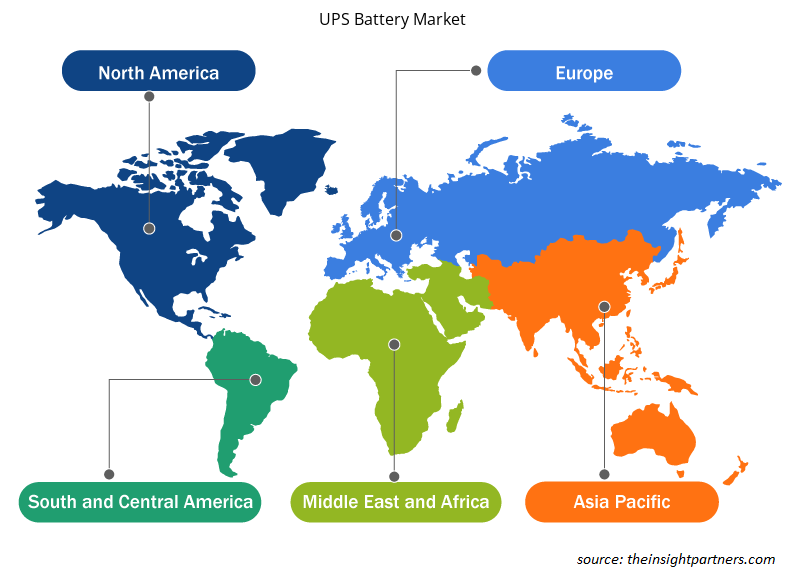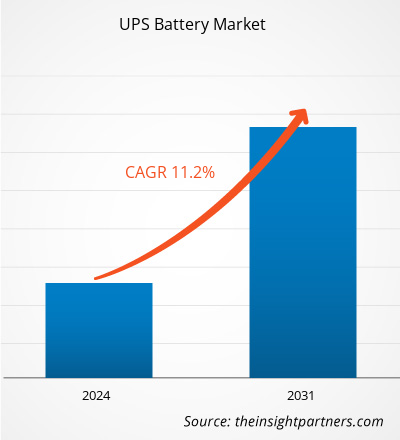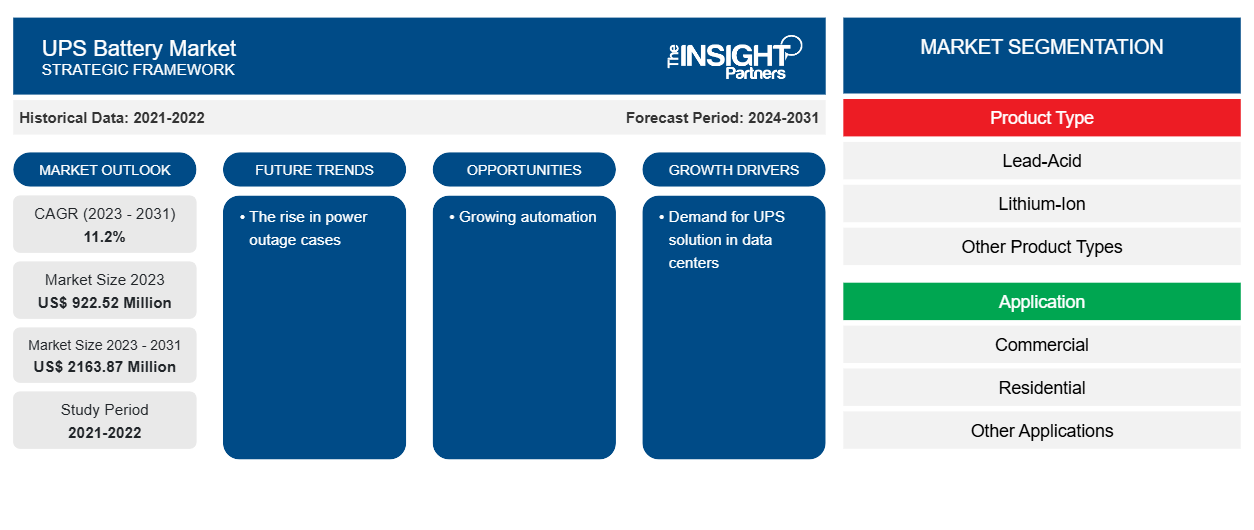Si prevede che la dimensione del mercato delle batterie UPS raggiungerà i 2.163,87 milioni di dollari entro il 2031, rispetto ai 922,52 milioni di dollari del 2023. Si prevede che il mercato registrerà un CAGR dell'11,2% nel periodo 2023-2031. L'aumento dei casi di interruzione di corrente e la crescita del settore residenziale e commerciale rimarranno probabilmente tendenze chiave nel mercato.
Analisi del mercato delle batterie UPS
La crescente costruzione di grandi data center nei settori aziendali e industriali genera la domanda di sistemi UPS, che spinge ulteriormente il mercato delle batterie UPS. La necessità di alimentazione continua per elettronica, strutture, gadget, infrastrutture critiche e altri dispositivi critici per la missione spinge ulteriormente la crescita del mercato. L'aumento dei casi di interruzione di corrente in tutto il mondo richiede ulteriormente soluzioni UPS, che spingono ulteriormente la crescita del mercato delle batterie UPS.
Panoramica del mercato delle batterie UPS
Una batteria di alimentazione ininterrotta (UPS) o una fonte di alimentazione UPS è un tipo di sistema di alimentazione che funge da accumulo di energia elettrica o backup durante interruzioni di corrente o problemi di interruzione di corrente. È comunemente utilizzato per proteggere hardware come data center, computer, apparecchiature di telecomunicazione o altre apparecchiature elettriche in cui un'interruzione di corrente imprevista potrebbe causare lesioni, decessi, gravi interruzioni aziendali o perdita di dati. L'aumento dei data center e del settore industriale sta guidando la crescita del mercato delle batterie UPS.
Personalizza questo report in base alle tue esigenze
Riceverai la personalizzazione gratuita di qualsiasi report, comprese parti di questo report, o analisi a livello nazionale, pacchetto dati Excel, oltre a usufruire di grandi offerte e sconti per start-up e università
-
Scopri le principali tendenze di mercato in questo rapporto.Questo campione GRATUITO includerà analisi di dati che spaziano dalle tendenze di mercato alle stime e alle previsioni.
Driver e opportunità del mercato delle batterie UPS
Domanda di soluzioni UPS nei data center
La soluzione UPS è un sistema cruciale per le infrastrutture dei data center mission-critical. La presenza di un sistema UPS fornisce energia costante ed efficiente nei data center. Supporta il grande data center quando la fonte di alimentazione primaria si interrompe. Gli utenti hanno bisogno di livelli più elevati di uptime. Questo fattore genera la necessità di una maggiore potenza per il funzionamento efficiente del data center. I sistemi UPS nel data center forniscono la quantità precisa di energia entro millisecondi dalla perdita di potenza. Pertanto, il crescente mercato dei data center favorisce la crescita del mercato delle batterie UPS.
Ampia gamma di utenti finali di batterie UPS
I principali utenti finali del mercato delle batterie UPS includono i settori commerciale, residenziale e industriale. Alimenti e bevande, prodotti farmaceutici, impianti di produzione di energia e aerospaziale sono alcuni dei settori cruciali circondati da possibilità di interruzioni di corrente e temperature ambiente molto elevate. A causa del fatto che le batterie UPS sono un componente chiave dell'UPS; È responsabile delle buone prestazioni e della lunga durata dell'UPS. Oltre al loro utilizzo, i data center, le aziende, gli elettrodomestici e i gadget elettrici sono altre applicazioni dell'UPS. Con la crescente penetrazione dell'UPS, la portata delle batterie UPS sarà ampliata.
Analisi della segmentazione del rapporto di mercato delle batterie UPS
I segmenti chiave che hanno contribuito alla derivazione dell'analisi di mercato delle batterie UPS sono il tipo di prodotto e l'applicazione.
- In base al tipo di prodotto, il mercato delle batterie UPS è suddiviso in piombo-acido, ioni di litio e altri tipi di prodotto. Si prevede che il segmento agli ioni di litio crescerà con il CAGR più elevato.
- Per applicazione, il mercato è segmentato in applicazioni commerciali, residenziali e altre. Il segmento commerciale ha detenuto una quota significativa del mercato nel 2023.
Analisi della quota di mercato delle batterie UPS per area geografica
L'ambito geografico del rapporto sul mercato delle batterie UPS è suddiviso principalmente in cinque regioni: Nord America, Asia Pacifico, Europa, Medio Oriente e Africa, Sud e Centro America.
La regione Asia-Pacifico ha detenuto la quota maggiore del mercato nel 2023. L'aumento della costruzione di data center genera la domanda di una domanda ininterrotta di alimentazione elettrica, che guida la crescita del mercato delle batterie UPS nella regione. Le autorità governative che forniscono sussidi e l'aumento degli investimenti degli operatori di mercato per la costruzione di data center iperscalabili guidano ulteriormente il mercato. L'aumento del settore residenziale sta guidando la crescita del mercato.
Approfondimenti regionali sul mercato delle batterie UPS
Le tendenze regionali e i fattori che influenzano il mercato delle batterie UPS durante il periodo di previsione sono stati ampiamente spiegati dagli analisti di Insight Partners. Questa sezione discute anche i segmenti e la geografia del mercato delle batterie UPS in Nord America, Europa, Asia Pacifico, Medio Oriente e Africa e America meridionale e centrale.

- Ottieni i dati specifici regionali per il mercato delle batterie UPS
Ambito del rapporto sul mercato delle batterie UPS
| Attributo del report | Dettagli |
|---|---|
| Dimensioni del mercato nel 2023 | 922,52 milioni di dollari USA |
| Dimensioni del mercato entro il 2031 | 2163,87 milioni di dollari USA |
| CAGR globale (2023-2031) | 11,2% |
| Dati storici | 2021-2022 |
| Periodo di previsione | 2024-2031 |
| Segmenti coperti |
Per tipo di prodotto
|
| Regioni e Paesi coperti |
America del Nord
|
| Leader di mercato e profili aziendali chiave |
|
Densità dei player del mercato delle batterie UPS: comprendere il suo impatto sulle dinamiche aziendali
Il mercato delle batterie UPS sta crescendo rapidamente, spinto dalla crescente domanda degli utenti finali dovuta a fattori quali l'evoluzione delle preferenze dei consumatori, i progressi tecnologici e una maggiore consapevolezza dei vantaggi del prodotto. Con l'aumento della domanda, le aziende stanno ampliando le loro offerte, innovando per soddisfare le esigenze dei consumatori e capitalizzando sulle tendenze emergenti, il che alimenta ulteriormente la crescita del mercato.
La densità degli operatori di mercato si riferisce alla distribuzione di aziende o società che operano in un particolare mercato o settore. Indica quanti concorrenti (operatori di mercato) sono presenti in un dato spazio di mercato in relazione alle sue dimensioni o al valore di mercato totale.
Le principali aziende che operano nel mercato delle batterie UPS sono:
- CSB Batteria Co., Ltd
- Azienda manifatturiera East Penn
- Società Eaton
- Exide Industries Limited
- FIAMM Energy Technology SpA
- GS Yuasa International Ltd
Disclaimer : le aziende elencate sopra non sono classificate secondo un ordine particolare.

- Ottieni una panoramica dei principali attori del mercato delle batterie UPS
Notizie e sviluppi recenti sul mercato delle batterie UPS
Il mercato delle batterie UPS viene valutato raccogliendo dati qualitativi e quantitativi dopo la ricerca primaria e secondaria, che include importanti pubblicazioni aziendali, dati associativi e database. Di seguito sono elencati alcuni degli sviluppi nel mercato delle batterie UPS:
- C&D Technologies, leader mondiale nelle soluzioni di accumulo di energia per gruppi di continuità (UPS) nel settore dei data center, ha introdotto la sua batteria VRLA Pure Lead Max (PLM) premium. La Pure Lead Max è la batteria VRLA più duratura per sistemi UPS nella gamma C&D e ha una garanzia leader del settore di otto anni. (Fonte: C&D Technologies, comunicato stampa, marzo 2023)
- Eaton ha annunciato il lancio globale del gruppo di continuità (UPS) agli ioni di litio 9PX. Basandosi sulla sua leadership nella fornitura di innovative capacità di batterie agli ioni di litio in soluzioni di alimentazione di backup, il nuovo UPS di Eaton offre una maggiore durata della batteria e un ingombro ridotto rispetto alla tecnologia UPS alimentata a batteria al piombo-acido regolata da valvola (VRLA), rendendolo ideale per ambienti distribuiti, "edge" e applicazioni industriali leggere che vanno dall'assistenza sanitaria all'istruzione. (Fonte: Eaton, comunicato stampa, luglio 2021)
Copertura e risultati del rapporto sul mercato delle batterie UPS
Il rapporto "Dimensioni e previsioni del mercato delle batterie UPS (2021-2031)" fornisce un'analisi dettagliata del mercato che copre le seguenti aree:
- Dimensioni e previsioni del mercato delle batterie UPS a livello globale, regionale e nazionale per tutti i principali segmenti di mercato coperti dall'ambito
- Tendenze del mercato delle batterie UPS e dinamiche di mercato come driver, vincoli e opportunità chiave
- Analisi dettagliata delle cinque forze PEST/Porter e SWOT
- Analisi del mercato delle batterie UPS che copre le principali tendenze del mercato, il quadro globale e regionale, i principali attori, le normative e i recenti sviluppi del mercato
- Analisi del panorama industriale e della concorrenza che copre la concentrazione del mercato, l'analisi della mappa di calore, i principali attori e gli sviluppi recenti per il mercato delle batterie UPS
- Profili aziendali dettagliati
- Analisi storica (2 anni), anno base, previsione (7 anni) con CAGR
- Analisi PEST e SWOT
- Valore/volume delle dimensioni del mercato - Globale, Regionale, Nazionale
- Industria e panorama competitivo
- Set di dati Excel
Report recenti
Rapporti correlati
Testimonianze
Motivo dell'acquisto
- Processo decisionale informato
- Comprensione delle dinamiche di mercato
- Analisi competitiva
- Analisi dei clienti
- Previsioni di mercato
- Mitigazione del rischio
- Pianificazione strategica
- Giustificazione degli investimenti
- Identificazione dei mercati emergenti
- Miglioramento delle strategie di marketing
- Aumento dell'efficienza operativa
- Allineamento alle tendenze normative























 Ottieni un campione gratuito per - Mercato delle batterie UPS
Ottieni un campione gratuito per - Mercato delle batterie UPS